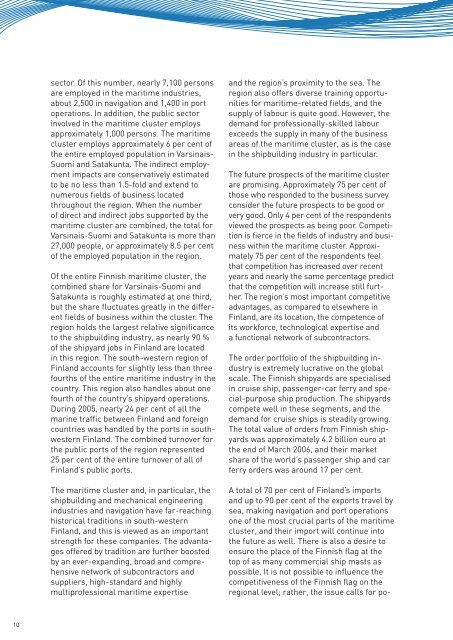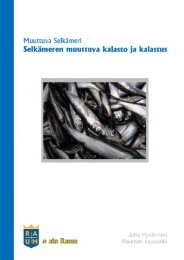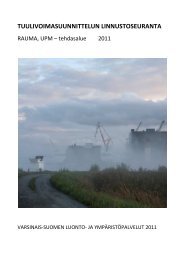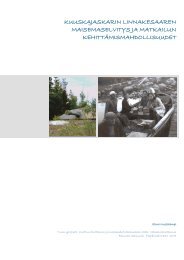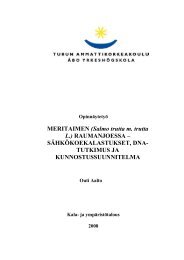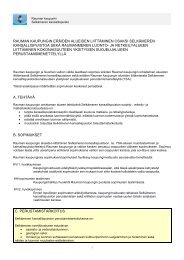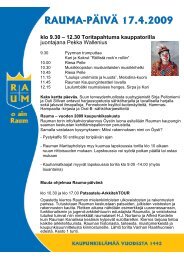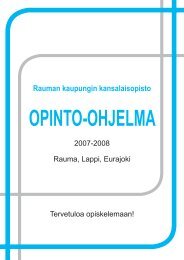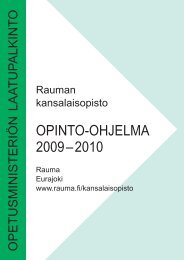Meriklusteriraportti (pdf 5,6 Mb) - Turku
Meriklusteriraportti (pdf 5,6 Mb) - Turku
Meriklusteriraportti (pdf 5,6 Mb) - Turku
You also want an ePaper? Increase the reach of your titles
YUMPU automatically turns print PDFs into web optimized ePapers that Google loves.
10<br />
sector. Of this number, nearly 7,100 persons<br />
are employed in the maritime industries,<br />
about 2,500 in navigation and 1,400 in port<br />
operations. In addition, the public sector<br />
involved in the maritime cluster employs<br />
approximately 1,000 persons. The maritime<br />
cluster employs approximately 6 per cent of<br />
the entire employed population in Varsinais-<br />
Suomi and Satakunta. The indirect employment<br />
impacts are conservatively estimated<br />
to be no less than 1.5-fold and extend to<br />
numerous fi elds of business located<br />
throughout the region. When the number<br />
of direct and indirect jobs supported by the<br />
maritime cluster are combined, the total for<br />
Varsinais-Suomi and Satakunta is more than<br />
27,000 people, or approximately 8.5 per cent<br />
of the employed population in the region.<br />
Of the entire Finnish maritime cluster, the<br />
combined share for Varsinais-Suomi and<br />
Satakunta is roughly estimated at one third,<br />
but the share fl uctuates greatly in the different<br />
fi elds of business within the cluster. The<br />
region holds the largest relative signifi cance<br />
to the shipbuilding industry, as nearly 90 %<br />
of the shipyard jobs in Finland are located<br />
in this region. The south-western region of<br />
Finland accounts for slightly less than three<br />
fourths of the entire maritime industry in the<br />
country. This region also handles about one<br />
fourth of the country’s shipyard operations.<br />
During 2005, nearly 24 per cent of all the<br />
marine traffi c between Finland and foreign<br />
countries was handled by the ports in southwestern<br />
Finland. The combined turnover for<br />
the public ports of the region represented<br />
25 per cent of the entire turnover of all of<br />
Finland’s public ports.<br />
The maritime cluster and, in particular, the<br />
shipbuilding and mechanical engineering<br />
industries and navigation have far-reaching<br />
historical traditions in south-western<br />
Finland, and this is viewed as an important<br />
strength for these companies. The advantages<br />
offered by tradition are further boosted<br />
by an ever-expanding, broad and comprehensive<br />
network of subcontractors and<br />
suppliers, high-standard and highly<br />
multiprofessional maritime expertise<br />
and the region’s proximity to the sea. The<br />
region also offers diverse training opportunities<br />
for maritime-related fi elds, and the<br />
supply of labour is quite good. However, the<br />
demand for professionally-skilled labour<br />
exceeds the supply in many of the business<br />
areas of the maritime cluster, as is the case<br />
in the shipbuilding industry in particular.<br />
The future prospects of the maritime cluster<br />
are promising. Approximately 75 per cent of<br />
those who responded to the business survey<br />
consider the future prospects to be good or<br />
very good. Only 4 per cent of the respondents<br />
viewed the prospects as being poor. Competition<br />
is fi erce in the fi elds of industry and business<br />
within the maritime cluster. Approximately<br />
75 per cent of the respondents feel<br />
that competition has increased over recent<br />
years and nearly the same percentage predict<br />
that the competition will increase still further.<br />
The region’s most important competitive<br />
advantages, as compared to elsewhere in<br />
Finland, are its location, the competence of<br />
its workforce, technological expertise and<br />
a functional network of subcontractors.<br />
The order portfolio of the shipbuilding industry<br />
is extremely lucrative on the global<br />
scale. The Finnish shipyards are specialised<br />
in cruise ship, passenger-car ferry and special-purpose<br />
ship production. The shipyards<br />
compete well in these segments, and the<br />
demand for cruise ships is steadily growing.<br />
The total value of orders from Finnish shipyards<br />
was approximately 4.2 billion euro at<br />
the end of March 2006, and their market<br />
share of the world’s passenger ship and car<br />
ferry orders was around 17 per cent.<br />
A total of 70 per cent of Finland’s imports<br />
and up to 90 per cent of the exports travel by<br />
sea, making navigation and port operations<br />
one of the most crucial parts of the maritime<br />
cluster, and their import will continue into<br />
the future as well. There is also a desire to<br />
ensure the place of the Finnish fl ag at the<br />
top of as many commercial ship masts as<br />
possible. It is not possible to infl uence the<br />
competitiveness of the Finnish fl ag on the<br />
regional level; rather, the issue calls for po-


